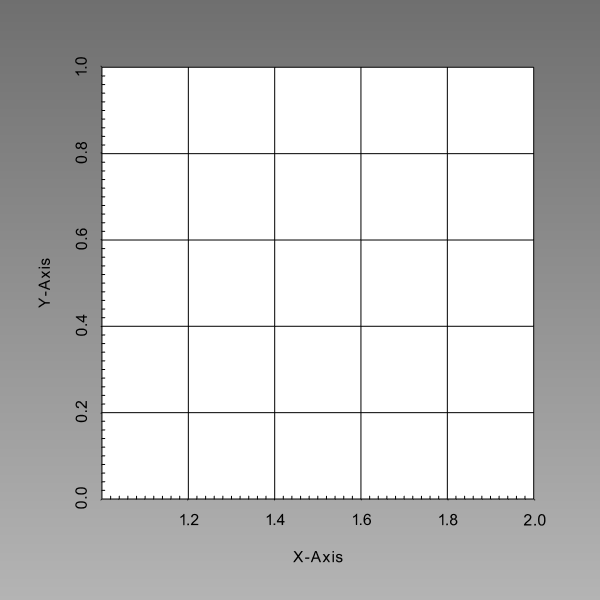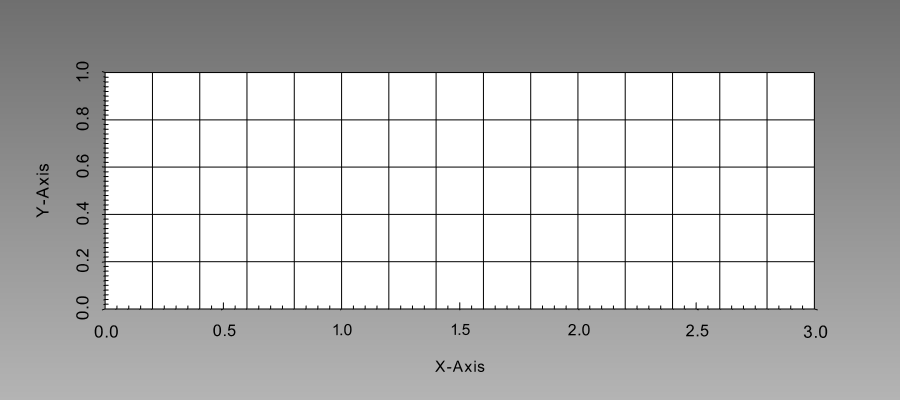- filesThe name of the mesh files to read. These mesh files will be 'stitched' into the current mesh in this order.
C++ Type:std::vector<MeshFileName>
Controllable:No
Description:The name of the mesh files to read. These mesh files will be 'stitched' into the current mesh in this order.
- stitch_boundariesPairs of boundary names (one after the other) to stitch together for each step.
C++ Type:std::vector<BoundaryName>
Controllable:No
Description:Pairs of boundary names (one after the other) to stitch together for each step.
StitchedMesh
Reads in all of the given meshes and stitches them all together into one mesh.
Overview
The StitchedMesh object allows for multiple mesh files to be "stitched" together to form a single mesh for use in a simulation. For example, consider the following three meshes.

Fig. 1: Left portion of "stitched" mesh (left.e).

Fig. 2: Center portion of "stitched" mesh (center.e).

Fig. 3: Right portion of "stitched" mesh (right.e).
Using the StitchedMesh object from within the Mesh block of the input file, as shown in the input file snippet below, these three square meshes are joined into a single mesh as shown in Figure 4.
[Mesh]
type = StitchedMesh
files = 'left.e center.e right.e'
stitch_boundaries = 'right left right left'
parallel_type = 'replicated'
[]

Fig. 4: Resulting "stitched" mesh from combination of three square meshes.
Input Parameters
- add_subdomain_idsThe listed subdomains will be assumed valid for the mesh. This permits setting up subdomain restrictions for subdomains initially containing no elements, which can occur, for example, in additive manufacturing simulations which dynamically add and remove elements.
C++ Type:std::vector<unsigned short>
Controllable:No
Description:The listed subdomains will be assumed valid for the mesh. This permits setting up subdomain restrictions for subdomains initially containing no elements, which can occur, for example, in additive manufacturing simulations which dynamically add and remove elements.
- allow_renumberingTrueIf allow_renumbering=false, node and element numbers are kept fixed until deletion
Default:True
C++ Type:bool
Controllable:No
Description:If allow_renumbering=false, node and element numbers are kept fixed until deletion
- build_all_side_lowerd_meshFalseTrue to build the lower-dimensional mesh for all sides.
Default:False
C++ Type:bool
Controllable:No
Description:True to build the lower-dimensional mesh for all sides.
- clear_stitched_boundary_idsTrueWhether or not to erase the boundary IDs after they've been used for stitching.
Default:True
C++ Type:bool
Controllable:No
Description:Whether or not to erase the boundary IDs after they've been used for stitching.
- coord_blockBlock IDs for the coordinate systems. If this parameter is specified, then it must encompass all the subdomains on the mesh.
C++ Type:std::vector<SubdomainName>
Controllable:No
Description:Block IDs for the coordinate systems. If this parameter is specified, then it must encompass all the subdomains on the mesh.
- ghosting_patch_sizeThe number of nearest neighbors considered for ghosting purposes when 'iteration' patch update strategy is used. Default is 5 * patch_size.
C++ Type:unsigned int
Controllable:No
Description:The number of nearest neighbors considered for ghosting purposes when 'iteration' patch update strategy is used. Default is 5 * patch_size.
- max_leaf_size10The maximum number of points in each leaf of the KDTree used in the nearest neighbor search. As the leaf size becomes larger,KDTree construction becomes faster but the nearest neighbor searchbecomes slower.
Default:10
C++ Type:unsigned int
Controllable:No
Description:The maximum number of points in each leaf of the KDTree used in the nearest neighbor search. As the leaf size becomes larger,KDTree construction becomes faster but the nearest neighbor searchbecomes slower.
- parallel_typeDEFAULTDEFAULT: Use libMesh::ReplicatedMesh unless --distributed-mesh is specified on the command line REPLICATED: Always use libMesh::ReplicatedMesh DISTRIBUTED: Always use libMesh::DistributedMesh
Default:DEFAULT
C++ Type:MooseEnum
Controllable:No
Description:DEFAULT: Use libMesh::ReplicatedMesh unless --distributed-mesh is specified on the command line REPLICATED: Always use libMesh::ReplicatedMesh DISTRIBUTED: Always use libMesh::DistributedMesh
- skip_refine_when_use_splitTrueTrue to skip uniform refinements when using a pre-split mesh.
Default:True
C++ Type:bool
Controllable:No
Description:True to skip uniform refinements when using a pre-split mesh.
Optional Parameters
- alpha_rotationThe number of degrees that the domain should be alpha-rotated using the Euler angle ZXZ convention from https://en.wikipedia.org/wiki/Euler_angles#Rotation_matrix in order to align with a canonical physical space of your choosing.
C++ Type:double
Controllable:No
Description:The number of degrees that the domain should be alpha-rotated using the Euler angle ZXZ convention from https://en.wikipedia.org/wiki/Euler_angles#Rotation_matrix in order to align with a canonical physical space of your choosing.
- beta_rotationThe number of degrees that the domain should be beta-rotated using the Euler angle ZXZ convention from https://en.wikipedia.org/wiki/Euler_angles#Rotation_matrix in order to align with a canonical physical space of your choosing.
C++ Type:double
Controllable:No
Description:The number of degrees that the domain should be beta-rotated using the Euler angle ZXZ convention from https://en.wikipedia.org/wiki/Euler_angles#Rotation_matrix in order to align with a canonical physical space of your choosing.
- gamma_rotationThe number of degrees that the domain should be gamma-rotated using the Euler angle ZXZ convention from https://en.wikipedia.org/wiki/Euler_angles#Rotation_matrix in order to align with a canonical physical space of your choosing.
C++ Type:double
Controllable:No
Description:The number of degrees that the domain should be gamma-rotated using the Euler angle ZXZ convention from https://en.wikipedia.org/wiki/Euler_angles#Rotation_matrix in order to align with a canonical physical space of your choosing.
- length_unitHow much distance one mesh length unit represents, e.g. 1 cm, 1 nm, 1 ft, 5inches
C++ Type:std::string
Controllable:No
Description:How much distance one mesh length unit represents, e.g. 1 cm, 1 nm, 1 ft, 5inches
- up_directionSpecify what axis corresponds to the up direction in physical space (the opposite of the gravity vector if you will). If this parameter is provided, we will perform a single 90 degree rotation of the domain--if the provided axis is 'x' or 'z', we will not rotate if the axis is 'y'--such that a point which was on the provided axis will now lie on the y-axis, e.g. the y-axis is our canonical up direction. If you want finer grained control than this, please use the 'alpha_rotation', 'beta_rotation', and 'gamma_rotation' parameters.
C++ Type:MooseEnum
Controllable:No
Description:Specify what axis corresponds to the up direction in physical space (the opposite of the gravity vector if you will). If this parameter is provided, we will perform a single 90 degree rotation of the domain--if the provided axis is 'x' or 'z', we will not rotate if the axis is 'y'--such that a point which was on the provided axis will now lie on the y-axis, e.g. the y-axis is our canonical up direction. If you want finer grained control than this, please use the 'alpha_rotation', 'beta_rotation', and 'gamma_rotation' parameters.
Transformations Relative To Parent Application Frame Of Reference Parameters
- coord_typeXYZType of the coordinate system per block param
Default:XYZ
C++ Type:MultiMooseEnum
Controllable:No
Description:Type of the coordinate system per block param
- rz_coord_axisYThe rotation axis (X | Y) for axisymmetric coordinates
Default:Y
C++ Type:MooseEnum
Controllable:No
Description:The rotation axis (X | Y) for axisymmetric coordinates
- rz_coord_blocksBlocks using general axisymmetric coordinate systems
C++ Type:std::vector<SubdomainName>
Controllable:No
Description:Blocks using general axisymmetric coordinate systems
- rz_coord_directionsAxis directions for each block in 'rz_coord_blocks'
C++ Type:std::vector<libMesh::VectorValue<double>>
Controllable:No
Description:Axis directions for each block in 'rz_coord_blocks'
- rz_coord_originsAxis origin points for each block in 'rz_coord_blocks'
C++ Type:std::vector<libMesh::Point>
Controllable:No
Description:Axis origin points for each block in 'rz_coord_blocks'
Coordinate System Parameters
- centroid_partitioner_directionSpecifies the sort direction if using the centroid partitioner. Available options: x, y, z, radial
C++ Type:MooseEnum
Controllable:No
Description:Specifies the sort direction if using the centroid partitioner. Available options: x, y, z, radial
- partitionerdefaultSpecifies a mesh partitioner to use when splitting the mesh for a parallel computation.
Default:default
C++ Type:MooseEnum
Controllable:No
Description:Specifies a mesh partitioner to use when splitting the mesh for a parallel computation.
Partitioning Parameters
- construct_node_list_from_side_listTrueWhether or not to generate nodesets from the sidesets (usually a good idea).
Default:True
C++ Type:bool
Controllable:No
Description:Whether or not to generate nodesets from the sidesets (usually a good idea).
- control_tagsAdds user-defined labels for accessing object parameters via control logic.
C++ Type:std::vector<std::string>
Controllable:No
Description:Adds user-defined labels for accessing object parameters via control logic.
- dim1This is only required for certain mesh formats where the dimension of the mesh cannot be autodetected. In particular you must supply this for GMSH meshes. Note: This is completely ignored for ExodusII meshes!
Default:1
C++ Type:MooseEnum
Controllable:No
Description:This is only required for certain mesh formats where the dimension of the mesh cannot be autodetected. In particular you must supply this for GMSH meshes. Note: This is completely ignored for ExodusII meshes!
- enableTrueSet the enabled status of the MooseObject.
Default:True
C++ Type:bool
Controllable:No
Description:Set the enabled status of the MooseObject.
- nemesisFalseIf nemesis=true and file=foo.e, actually reads foo.e.N.0, foo.e.N.1, ... foo.e.N.N-1, where N = # CPUs, with NemesisIO.
Default:False
C++ Type:bool
Controllable:No
Description:If nemesis=true and file=foo.e, actually reads foo.e.N.0, foo.e.N.1, ... foo.e.N.N-1, where N = # CPUs, with NemesisIO.
- patch_size40The number of nodes to consider in the NearestNode neighborhood.
Default:40
C++ Type:unsigned int
Controllable:No
Description:The number of nodes to consider in the NearestNode neighborhood.
- patch_update_strategyneverHow often to update the geometric search 'patch'. The default is to never update it (which is the most efficient but could be a problem with lots of relative motion). 'always' will update the patch for all secondary nodes at the beginning of every timestep which might be time consuming. 'auto' will attempt to determine at the start of which timesteps the patch for all secondary nodes needs to be updated automatically.'iteration' updates the patch at every nonlinear iteration for a subset of secondary nodes for which penetration is not detected. If there can be substantial relative motion between the primary and secondary surfaces during the nonlinear iterations within a timestep, it is advisable to use 'iteration' option to ensure accurate contact detection.
Default:never
C++ Type:MooseEnum
Controllable:No
Description:How often to update the geometric search 'patch'. The default is to never update it (which is the most efficient but could be a problem with lots of relative motion). 'always' will update the patch for all secondary nodes at the beginning of every timestep which might be time consuming. 'auto' will attempt to determine at the start of which timesteps the patch for all secondary nodes needs to be updated automatically.'iteration' updates the patch at every nonlinear iteration for a subset of secondary nodes for which penetration is not detected. If there can be substantial relative motion between the primary and secondary surfaces during the nonlinear iterations within a timestep, it is advisable to use 'iteration' option to ensure accurate contact detection.